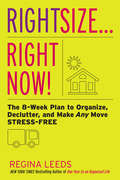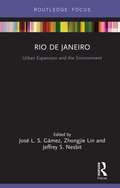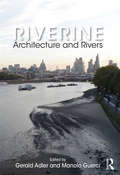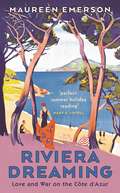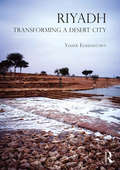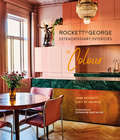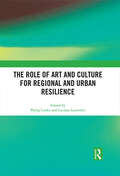- Table View
- List View
The Right to Home: Exploring How Space, Culture, and Identity Intersect with Disparities
by Tasoulla HadjiyanniThis book explores how the design characteristics of homes can support or suppress individuals’ attempts to create meaning in their lives, which in turn, impacts well-being and delineates the production of health, income, and educational disparities within homes and communities. According to the author, the physical realities of living space—such as how kitchen layouts restrict cooking and the size of social areas limits gatherings with friends, or how dining tables can shape aspirations—have a salient connection to the beliefs, culture, and happiness of the individuals in the space. The book’s purpose is to examine the human capacity to create meaning and to rally home mediators (scholars, educators, design practitioners, policy makes, and advocates) to work toward Culturally Enriched Communities in which everyone can thrive. The volume includes stories from Hmong, Somali, Mexican, Ojibwe, and African American individuals living in Minnesota to show how space intersects with race, gender, citizenship, ability, religion, and ethnicity, positing that social inequalities are partially spatially constructed and are, therefore, malleable.
The Right to Transportation: Moving to Equity
by Thomas SanchezDoes transportation affect the lives of minority, low-income, elderly, and physically disabled citizens? The answer is yes, and those effects can be profound, according to The Right to Transportation. The authors argue that transportation policies can limit access to education, jobs, and services for some individuals while undermining the economy and social cohesion of entire communities. Policies that have nurtured the U.S. highway system and let public transportation wither have also led to ghettos and social isolation. More and more communities are recognizing the problem. This book explains the strategies and policies that can address inequities in the nation's transportation and transportation planning systems so that the benefits and burdens of those systems can be shared equally across all communities. With a close examination of how transportation policies affect individuals and communities, the book is a guide to transportation fairness. It explains the demographic trends, historical events, and current policies that have shaped transportation in the U.S. and offers recommendations for moving to equity.
The Right to Transportation: Moving to Equity
by Thomas SanchezDoes transportation affect the lives of minority, low-income, elderly, and physically disabled citizens? The answer is yes, and those effects can be profound, according to The Right to Transportation. The authors argue that transportation policies can limit access to education, jobs, and services for some individuals while undermining the economy and social cohesion of entire communities. Policies that have nurtured the U.S. highway system and let public transportation wither have also led to ghettos and social isolation. More and more communities are recognizing the problem. This book explains the strategies and policies that can address inequities in the nation's transportation and transportation planning systems so that the benefits and burdens of those systems can be shared equally across all communities. With a close examination of how transportation policies affect individuals and communities, the book is a guide to transportation fairness. It explains the demographic trends, historical events, and current policies that have shaped transportation in the U.S. and offers recommendations for moving to equity.
Rightsize . . . Right Now!: The 8-Week Plan to Organize, Declutter, and Make Any Move Stress-Free
by Regina LeedsGet ready for moving day the stress-free wayWhether your new home is across the country or across the street, moving is never easy. Between the packing, the hauling, and the unpacking--let alone the clutter of boxes, the misplaced items, and the upheaval of leaving the old place behind--the stress can overwhelm even the most easygoing person. But with the right plan, it doesn't have to be that way!For over 25 years, bestselling author and professional organizer Regina Leeds has helped her clients prepare for new homes with practical support and a fresh perspective. She sees moving as an opportunity to simplify and start fresh. In Rightsize ... Right Now! Regina outlines her 8-week plan to clear clutter, organize, pack, and relocate without stress, with:Helpful guidance on making a moving plan, from hiring movers down to forwarding mailStrategies to tackle each room in the house in a smart, efficient wayRightsizing projects to weed out unneeded possessionsExpert advice on organizing your belongings for the move and the new homeWeekly self-care tips to keep you from getting bogged downNo matter if you're going from dorm to apartment, house to house, castle tocondo, or you're preparing for retirement, Rightsize ... Right Now! will help you to conquer the chaos of moving and settle into a simpler, cleaner home.
Rightsize . . . Right Now!: The 8-Week Plan to Organize, Declutter, and Make Any Move Stress-Free
by Regina LeedsGet ready for moving day the stress-free way Whether your new home is across the country or across the street, moving is never easy. Between the packing, the hauling, and the unpacking -- let alone the clutter of boxes, the misplaced items, and the upheaval of leaving the old place behind -- the stress can overwhelm even the most easygoing person. But with the right plan, it doesn't have to be that way! For over 25 years, bestselling author and professional organizer Regina Leeds has helped her clients prepare for new homes with practical support and a fresh perspective. She sees moving as an opportunity to simplify and start fresh. In Rightsize . . . Right Now! Regina outlines her 8-week plan to clear clutter, organize, pack, and relocate without stress, with: Helpful guidance on making a moving plan, from hiring movers down to forwarding mail Strategies to tackle each room in the house in a smart, efficient way Rightsizing projects to weed out unneeded possessions Expert advice on organizing your belongings for the move and the new home Weekly self-care tips to keep you from getting bogged down No matter if you're going from dorm to apartment, house to house, castle to condo, or you're preparing for retirement, Rightsize . . . Right Now! will help you to conquer the chaos of moving and settle into a simpler, cleaner home.
Rio de Janeiro: Urban Expansion and the Environment (Built Environment City Studies)
by José L. S. Gámez Zhongjie Lin Jeffrey S. NesbitUsing Rio de Janeiro as the case study city, this book highlights and examines issues surrounding the development of mega-cities in Latin America and beyond. Complex dynamics of urbanization such as mega-event-driven development, infrastructure investment, and informal urban expansion are intertwined with changing climatic conditions that demand new approaches to sustainable urbanism. The urban conditions facing 21st century cities such as Rio emphasize the need to revisit urban forms, reintegrate infrastructure, and re-evaluate practices. With contributions from 15 scholars from several countries exploring urbanism, urbanization, and climate change, this book provides insights into the contextual and environmental issues shaping Rio in the age of globalization. Each of the book’s three sections addresses an interdisciplinary range of topics impacting urbanism in Latin America, which will be accessible to researchers and professionals interested in urbanization, urban design, sustainability, planning, and architecture.
Rio de Janeiro: Urban Expansion and the Environment (Built Environment City Studies)
by José L. S. Gámez Zhongjie Lin Jeffrey S. NesbitUsing Rio de Janeiro as the case study city, this book highlights and examines issues surrounding the development of mega-cities in Latin America and beyond. Complex dynamics of urbanization such as mega-event-driven development, infrastructure investment, and informal urban expansion are intertwined with changing climatic conditions that demand new approaches to sustainable urbanism. The urban conditions facing 21st century cities such as Rio emphasize the need to revisit urban forms, reintegrate infrastructure, and re-evaluate practices. With contributions from 15 scholars from several countries exploring urbanism, urbanization, and climate change, this book provides insights into the contextual and environmental issues shaping Rio in the age of globalization. Each of the book’s three sections addresses an interdisciplinary range of topics impacting urbanism in Latin America, which will be accessible to researchers and professionals interested in urbanization, urban design, sustainability, planning, and architecture.
The Rise of Build to Rent in the UK
by Brendan KilpatrickBuild to Rent (BTR) is a form of residential tenure which first emerged in the United States, where it is known as Multifamily Housing. While it has been a mature asset in the United States for over a decade, it is relatively new to the UK and Ireland. The Rise of Build to Rent in the UK examines how this type of housing can play a key role in streamlining design and construction activity in a forward-facing manner which embraces climate change resilience and digital methods for delivery and management within the circular economy. The book examines the background of traditional UK home-owning and renting from which this new sector emerged, and charts BTR’s momentum swing in 2016 and on-going expansion to the present day, describing the potential of the BTR model in terms of both economic and climate sustainability and evaluating the key ingredients to success. The Rise of Build to Rent in the UK concludes with five highly illustrated UK case studies which evaluate the practical deliverability of real world BTR projects. This book will be of interest to BTR operators and investors, constructors, housing associations, municipal authorities and students of architecture and urban planning.
The Rise of Build to Rent in the UK
by Brendan KilpatrickBuild to Rent (BTR) is a form of residential tenure which first emerged in the United States, where it is known as Multifamily Housing. While it has been a mature asset in the United States for over a decade, it is relatively new to the UK and Ireland. The Rise of Build to Rent in the UK examines how this type of housing can play a key role in streamlining design and construction activity in a forward-facing manner which embraces climate change resilience and digital methods for delivery and management within the circular economy. The book examines the background of traditional UK home-owning and renting from which this new sector emerged, and charts BTR’s momentum swing in 2016 and on-going expansion to the present day, describing the potential of the BTR model in terms of both economic and climate sustainability and evaluating the key ingredients to success. The Rise of Build to Rent in the UK concludes with five highly illustrated UK case studies which evaluate the practical deliverability of real world BTR projects. This book will be of interest to BTR operators and investors, constructors, housing associations, municipal authorities and students of architecture and urban planning.
Riverine: Architecture and Rivers
by Gerald Adler Manolo GuerciRiverscapes are the main arteries of the world’s largest cities, and have, for millennia, been the lifeblood of the urban communities that have developed around them. These human settlements – given life through the space of the local waterscape – soon developed into ritualised spaces that sought to harness the dynamism of the watercourse and create the local architectural landscape. Theorised via a sophisticated understanding of history, space, culture, and ecology, this collection of wonderful and deliberately wide-ranging case studies, from Early Modern Italy to the contemporary Bengal Delta, investigates the culture of human interaction with rivers and the nature of urban topography. Riverine explores the ways in which architecture and urban planning have imbued cultural landscapes with ritual and structural meaning.
Riverine: Architecture and Rivers
by Gerald Adler Manolo GuerciRiverscapes are the main arteries of the world’s largest cities, and have, for millennia, been the lifeblood of the urban communities that have developed around them. These human settlements – given life through the space of the local waterscape – soon developed into ritualised spaces that sought to harness the dynamism of the watercourse and create the local architectural landscape. Theorised via a sophisticated understanding of history, space, culture, and ecology, this collection of wonderful and deliberately wide-ranging case studies, from Early Modern Italy to the contemporary Bengal Delta, investigates the culture of human interaction with rivers and the nature of urban topography. Riverine explores the ways in which architecture and urban planning have imbued cultural landscapes with ritual and structural meaning.
Rivets, Trivets and Galvanised Buckets: Life in the village hardware shop
by Tom FortTom Fort made his name as a writer with his bestselling travel narrative The A303: Highway to the Sun. He now focuses on matters closer to home by celebrating a quintessential cornerstone of any village in Britain - the shop - in this case a century-old hardware shop daughter-in-law bought eighteen months before the pandemic struck the UK to run herself in their beautiful Berkshire village, outside of Reading. The family's dream of developing the shop into one that would become the centre of village life certainly did come true, but for a very different set of circumstances. Rivets, Trivets and Galvanised Buckets interweaves the evolution of the shop, its previous owners, and the history of the items it sells, to its customers to present a delightful study of community and the eccentricities of ordinary people.The nationwide lockdown focused minds on the home and its immediate surroundings, i.e. the garden. People were forced to look differently at where they lived, and found ways to value that, and enhance it. They learned or relearned the pleasure and fulfilment of deploying practical skills. And they came to Tom's family shop to buy and to talk about what all this meant to them. Married to this personal story will be Tom's history of home ownership and how it nourished pride in the home and the desire to make the home better and more beautiful, and how technological progress in the mass production of tools and materials made it easy to realise - or attempt to realise - those ambitions.Rivets, Trivets and Galvanised Buckets offers fascinating history of technological progress: who thought of screwdrivers, where the spirit level came from, who devised the process of galvanisation, what genius worked out that a suction pad on the end of a piece of wood could unblock sinks and so forth. As Tom recounts: 'A little girl came with her father into Heath and Watkins, looked around for a while and said to him "Daddy, this is the shop of EVERYTHING". This is the story of how this happened.
Riviera Dreaming: Love and War on the Côte d'Azur (20120730 Ser. #20120730)
by Maureen EmersonIn 1926 Barry Dierks, a young American architect, arrived in Paris and fell in love with France... With his partner, an ex-officer in the British Army, he built a white, flat-roofed Modernist masterpiece that rested on the rocks below the Esterel, with views across the Mediterranean. They called it Le Trident. From the moment it was built, it captivated the Riviera. As commissions for more villas flooded in, Barry Dierks and Eric Sawyer, "those two charmers", flourished at the heart of Riviera society. Over the years, Dierks would design and build over 70 of the Riviera's most recognisable villas for clients ranging from Somerset Maugham's Villa Mauresque and Jack Warner's Villa Aujourd'hui to the Marquess of Cholmondeley's Villa Le Roc, and Maxine Elliott's Chateau de l'Horizon, later the home of Aly Khan and Rita Hayworth. Riviera Dreaming tells the dazzling story of the lives, loves and adventures that played out behind the walls of these glamorous houses and provides an unparalleled portrait of life on the Cote d'Azur at the height of the Jazz Age.
Riyadh: Transforming a Desert City (Planning, History and Environment Series)
by Yasser ElsheshtawyRiyadh has set its sights on becoming a world city befitting the twenty-first century. To that end it has embarked on a massive construction drive evidenced in the proliferation of proposals for high-end districts, giga-developments and elaborate infrastructures. An urban vision seemingly dedicated to attracting global capital. Yet such a narrative can be misleading. A ‘humanization programme’, initiated during the tenure of its former mayor Abdulaziz bin Ayyaf, has complemented the city’s rapid rise by providing spaces catering for the everyday needs of its inhabitants. Yasser Elsheshtawy, in this richly illustrated book, targets these people-centred settings. It is a compelling counter-narrative interweaving critical theoretical insights, personal observations, and serendipitous encounters. He deftly demonstrates how Riyadh thrives through the actions of its people. As the world moves towards an urban model that is resilient and humane, the humanizing efforts of an Arab city are worthy of our attention. Riyadh’s premise is perhaps best captured in the cover image depicting the desert riverbed of Wadi Sulai, filled with rainwater, making its way towards the Saudi capital. Along its banks there will be dedicated public pathways and urban parks. It is a vision of an urbanity where both the spectacular and the everyday coexist. A city that is not just dedicated to the few, but one that serves the many.
Riyadh: Transforming a Desert City (Planning, History and Environment Series)
by Yasser ElsheshtawyRiyadh has set its sights on becoming a world city befitting the twenty-first century. To that end it has embarked on a massive construction drive evidenced in the proliferation of proposals for high-end districts, giga-developments and elaborate infrastructures. An urban vision seemingly dedicated to attracting global capital. Yet such a narrative can be misleading. A ‘humanization programme’, initiated during the tenure of its former mayor Abdulaziz bin Ayyaf, has complemented the city’s rapid rise by providing spaces catering for the everyday needs of its inhabitants. Yasser Elsheshtawy, in this richly illustrated book, targets these people-centred settings. It is a compelling counter-narrative interweaving critical theoretical insights, personal observations, and serendipitous encounters. He deftly demonstrates how Riyadh thrives through the actions of its people. As the world moves towards an urban model that is resilient and humane, the humanizing efforts of an Arab city are worthy of our attention. Riyadh’s premise is perhaps best captured in the cover image depicting the desert riverbed of Wadi Sulai, filled with rainwater, making its way towards the Saudi capital. Along its banks there will be dedicated public pathways and urban parks. It is a vision of an urbanity where both the spectacular and the everyday coexist. A city that is not just dedicated to the few, but one that serves the many.
Robot (Large Print)
by Rnib BookshareHere is a picture of a toy robot standing up and facing forwards. There is a locator dot shown, which will be at the top left of the page when the image is the right way up. At the top of the page is its big wide, head with two ears sticking out. It has wide eyes, a small nose and a very wide smiley mouth. Its square body is below with an, arm on either side. The claw-shaped hands have two fingers. At the bottom of the page are its legs with clumpy feet at the bottom.
Robot (UEB Contracted)
by Rnib BookshareHere is a picture of a toy robot standing up and facing forwards. There is a locator dot shown, which will be at the top left of the page when the image is the right way up. At the top of the page is its big wide, head with two ears sticking out. It has wide eyes, a small nose and a very wide smiley mouth. Its square body is below with an, arm on either side. The claw-shaped hands have two fingers. At the bottom of the page are its legs with clumpy feet at the bottom.
Robot (UEB Uncontracted)
by Rnib BookshareHere is a picture of a toy robot standing up and facing forwards. There is a locator dot shown, which will be at the top left of the page when the image is the right way up. At the top of the page is its big wide, head with two ears sticking out. It has wide eyes, a small nose and a very wide smiley mouth. Its square body is below with an, arm on either side. The claw-shaped hands have two fingers. At the bottom of the page are its legs with clumpy feet at the bottom.
Rock Gardening: Reimagining a Classic Style
by Joseph TychonievichRock Gardening brings a classic garden style to a new generation of gardeners. It includes a survey of gorgeous rock gardens from around the world, the techniques and methods specific to creating and maintaining a rock garden, and profiles of the top 50 rock garden plants.
Rockett St George: Show-stopping Looks For Unique Interiors
by Jane RockettSelf-acknowledged ‘design junkies’ Lucy St George and Jane Rockett launched their online interiors store in 2007. Ten years on, Rockett St George has revitalized the interiors market with their quirky, glamorous and distinctive collections.
Rockett St George Extraordinary Interiors In Colour: Show-stopping Looks For Unique Interiors
by Lucy St GeorgeIn Extraordinary Interiors In Colour, self-confessed colour addicts Jane Rockett and Lucy St George follow on from their best-selling first book by tackling the topic of choosing colour for the home.
Rocking horse (large print)
by RnibThis is a picture of a dappled grey Edwardian rocking horse. There is a locator dot shown, which will be at the top left of the page when the image is the correct way up. The rocking horse is seen from the side and is facing to the left. Only one of its ears, eyes and nostrils can be found and only one front leg and back leg. The horses head is in the top centre of the page with its ear to the left. Down from this you can find its brown leather bridle, its eye, nostril and mouth. The horses neck is to the right of its head and the pale yellow hair of its mane is to the right of this. You can follow its neck down to its body on the right. The horses reins go right from its mouth. Further to the right is the saddle where you sit, and down from this is the loop of the stirrup where you put your foot. Moving right again you will find the horses hindquarters and right from this its long yellow tail. Its back leg goes down and right and its front leg goes down and left to the curved rocker, which has spiral ends on the left and right of the page.
Rocking horse (UEB contracted)
by RnibThis is a picture of a dappled grey Edwardian rocking horse. There is a locator dot shown, which will be at the top left of the page when the image is the correct way up. The rocking horse is seen from the side and is facing to the left. Only one of its ears, eyes and nostrils can be found and only one front leg and back leg. The horses head is in the top centre of the page with its ear to the left. Down from this you can find its brown leather bridle, its eye, nostril and mouth. The horses neck is to the right of its head and the pale yellow hair of its mane is to the right of this. You can follow its neck down to its body on the right. The horses reins go right from its mouth. Further to the right is the saddle where you sit, and down from this is the loop of the stirrup where you put your foot. Moving right again you will find the horses hindquarters and right from this its long yellow tail. Its back leg goes down and right and its front leg goes down and left to the curved rocker, which has spiral ends on the left and right of the page.
Rocking horse (UEB uncontracted)
by RnibThis is a picture of a dappled grey Edwardian rocking horse. There is a locator dot shown, which will be at the top left of the page when the image is the correct way up. The rocking horse is seen from the side and is facing to the left. Only one of its ears, eyes and nostrils can be found and only one front leg and back leg. The horses head is in the top centre of the page with its ear to the left. Down from this you can find its brown leather bridle, its eye, nostril and mouth. The horses neck is to the right of its head and the pale yellow hair of its mane is to the right of this. You can follow its neck down to its body on the right. The horses reins go right from its mouth. Further to the right is the saddle where you sit, and down from this is the loop of the stirrup where you put your foot. Moving right again you will find the horses hindquarters and right from this its long yellow tail. Its back leg goes down and right and its front leg goes down and left to the curved rocker, which has spiral ends on the left and right of the page.
The Role of Art and Culture for Regional and Urban Resilience
by Philip Cooke Luciana LazzerettiThis book analyses the influence of art and culture as an engine to promote the resilience of regional and urban economies. Under a multidiscplinary perspective, the book examines the contribution of some creative regions and cities as places in which processes of transformation, innovation and growth are activated in response to external pressures. Through different theoretical frameworks and empirical investigations and suggesting a critical discussion of the notion of resilience, the authors argue that cultural and creative resources may offer a sustainable model in order to afford different typologies of shocks. The book will appeal scholars of regional and urban science and cultural and creative economies and will open up a number of considerations for policy makers.This volume was originally published as a special issue of European Planning Studies.


